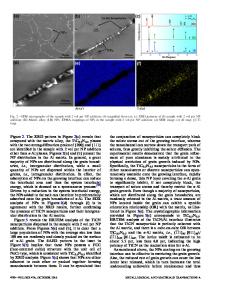Behavior of Boron in Molten Aluminum and its Grain Refinement Mechanism
- PDF / 582,466 Bytes
- 7 Pages / 593.972 x 792 pts Page_size
- 16 Downloads / 283 Views
N
THE addition of grain refiners into molten aluminum alloys is a common industrial practice to suppress the growth of columnar grains, to promote the formation of fine grains, and to improve castability and product quality. Grain refiners are usually added as Al-based master alloys that are rich in at least one of the following elements: titanium, boron and carbon. There are several types of grain refiners. Those produced by reaction of molten aluminum with halide salts (K2TiF6 and KBF4) and containing 5 pct Ti and 1 pct B, are the most widely used by industry. Their typical microstructure consists of TiB2 particles, TiAl3 needles and Ti solute in an aluminum matrix. Small additions of such master alloys in aluminum alloys (usually at 0.01 pct Ti and 0.002 pct B levels) result in a fine and equiaxed solidification microstructure. An appropriate temperature of addition practically lies between the liquids and 1073 K (800 °C). A great deal of fundamental research has been done over the past 50 years in order to understand the possible mechanisms by which grain refiners yield a fine microstructure. The majority of fundamental research works have focused on the refining mechanisms of Al-Ti-B master alloys and several theories have been postulated in this matter which were summarized in very useful comprehensive reviews.[1–4] According to these theories, the refinement effect could be ascribed to two phenomena: (i) the growth restriction factor and (ii) the inoculation and heterogeneous nucleation. The growth restriction is explained by the diffusion of solute atoms at the liquid/solid interface. In the inoculation theory, HOUSHANG D. ALAMDARI and DOMINIQUE DUBE´, Professors, are with the Department of Mining, Metallurgical and Materials Engineering, Laval University, Quebec, QC, G1K 7P4, Canada. Contact e-mail: [email protected] PASCAL TESSIER, Senior Research Scientist, is with Air Liquide Research and Development, Delaware Research and Technology Center, 200 GBC Drive, Newark, DE, 19702. Manuscript submitted February 7, 2012. METALLURGICAL AND MATERIALS TRANSACTIONS A
however, a-Al grains grow on the nucleation sites that are introduced in the liquid metal by the master alloy. Small particles of TiAl3, (Ti-Al)B2, and TiB2[5–9] have been proposed as potential nuclei contributing to the formation of a-Al and the efficiency and stability of these particles have been extensively studied. According to a general consensus, the heterogeneous nucleation of aluminum is attributed to the presence of TiB2 particles when an Al-Ti-B refiner is used. Some experimental evidence confirmed the nucleation potential of TiB2 particles, while it was also shown that TiB2 could be surrounded by a thin layer of TiAl3 phase which acts as the nucleation site.[10–15] Although the efficiency of grain refiners has been improved considerably over the past decades, there are still several issues which need to be addressed. One of these issues is the difficulty of controlling the size, morphology and agglomeration of TiB2 particles in Al-Ti-B master allo
Data Loading...










